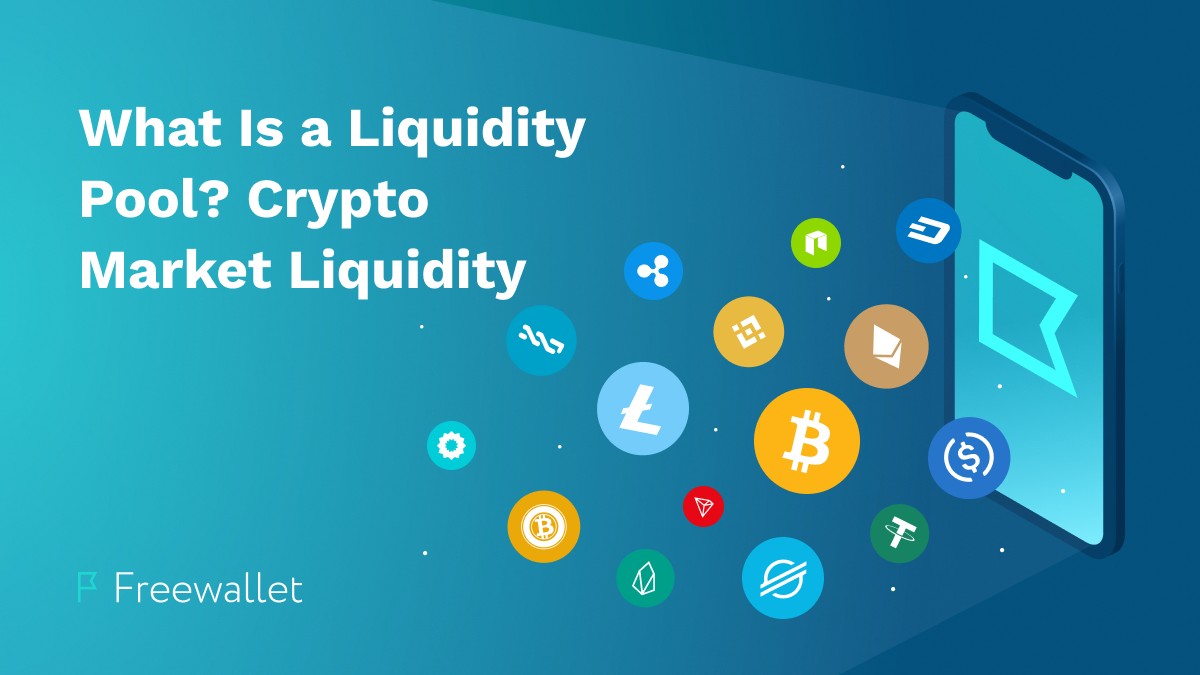
Liquidity pools in crypto managed to solve some urgent problems related to decentralized finance – DeFi.
That’s why they’re pivotal to the correct functioning and development of crypto solutions made for expert crypto enthusiasts who want to have full control over their digital assets. Starting from a definition of what a liquidity pool is in crypto, we’ll analyze the characteristics, advantages and possible drawbacks of these pools.
What is a crypto liquidity pool?
A liquidity pool is, in simple terms, a pool made up of two cryptocurrencies that collect the liquidity invested by DeFi users.
They’re able to provide investors with specific markets for DeFi, so they will be able to trade a particular pair even if there’s no central management to control the levels of liquidity of an exchange.
Moreover, the structure of liquidity pools allows different protocols to set strategies to reward liquidity providers. Otherwise, it might be difficult for them to acquire the right level of liquidity and they would incur all the issues we’ll see in detail later.
To better understand these points, let’s see how liquidity pools work.
How Do Crypto Liquidity Pools Work?
To better understand what a liquidity pool is in crypto, we need to understand its underlying technology.
Being a pivotal part of the DeFi market, it’s clear that it wouldn’t make sense to have centralized management for exchanges that use full decentralization as their strength.
So, to control liquidity in DeFi exchanges, smart contracts play a fundamental role: smart contracts allow for the complete automation of the structure of DeFi market makers, special algorithms that manage to lock the liquidity invested by participants and allow trades according to specific predetermined calculations.
Let’s see a practical example.
Uniswap is, without a doubt, one of the most popular decentralized exchanges available. Thanks to its AMM (Automated Market Maker), it can keep prices fair – by collecting information about prices from different exchanges and automatically setting the ratios between the tokens of each pair.
Thanks to liquidity pools, investors and traders can exchange cryptocurrencies and provide liquidity. Each pair becomes a specific market, and those who provide liquidity are rewarded with part of the fees generated by the trades that occur in that liquidity pool.
Thanks to smart contracts, everything is managed, so there is no need for intermediaries and centralized databases.
Liquidity pools vs. order book
A good analogy for a deeper understanding of what a liquidity pool is in crypto is the order book.
Actually, we could say that liquidity pools are the counterparts of order books in DeFi. Order books are the result of centralized management, and collect all buying and selling orders. Centralized exchanges use order books to make traders and investors understand how other participants behave and the market’s liquidity depth.
This system can’t be used by decentralized exchanges, since they rely on distribution and decentralization instead of centralization.
In DeFi, traders and investors are those who provide liquidity, stabilize the market and allow an exchange to work properly. In DeFi, traders don’t trade according to the buying and selling orders placed by other traders and don’t benefit from the reserves of centralized exchanges. They simply trade against the pool.
Liquidity pool vs. Order book – examples: one of the liquidity pools of PancakeSwap and the order book of Binance.
The Role of Crypto Liquidity Pools in DeFi
Liquidity pools are the tools that can be used by traders to participate in DeFi markets.
They’re able to make the whole decentralized system work properly since they’re what allow DeFi exchanges to gather liquidity and place trading orders.
The more liquidity gathered in a specific liquidity pool, the more stable the market is represented by that liquidity pool.
And the more stable a market is, the more possibilities there are for an exchange to attract institutional investors and avoid volatility-related issues for anyone.
Why Are Crypto Liquidity Pools Important?
With a current TVL (Total Value Locked) of over $60 billion, according to DefiLlama, the decentralized market plays a pivotal role in the financial market, and it managed to bring the crypto space closer to the traditional market.
If you think about that, most decentralized exchanges and protocols are built on Ethereum. The flexibility of its language allowed developers around the world to create complex infrastructures, applications, and businesses, making it hard for crypto detractors to say that cryptocurrencies have no real value.
But would it be possible without liquidity pools and market makers? Maybe not.
Liquidity pools allow the collection of liquidity and give decentralized protocols’ tokens the opportunity to find a place to raise funds and create new markets.
In fact, the main reason why liquidity pools are pivotal is that they allow for the stabilization of markets.
Consider that a highly volatile market is the consequence of a low level of liquidity. This has mainly two repercussions:
- Institutional investors stay away from too volatile markets;
- Low liquidity is the main cause of risks like slippage, which can affect big players as well as everyday traders.
Without a system to reach the necessary levels of liquidity, the DeFi space would never be able to create an inclusive space people can use to make money, create businesses, and have full control over their finances – even in those cases in which certain individuals are refused by the traditional financial market.
According to data collected and shared by the World Bank, in 2021, 1.4 billion people around the world were unbanked.
Decentralized finance, and cryptocurrencies and fintech in general, help to lower these barriers, especially when the cause of the condition of the unbanked is poor credit history.
Yield Farming and Liquidity Pools
Yield farming and crypto liquidity pools are strictly interconnected.
When traders and investors provide liquidity to a pool, they become liquidity providers and earn, as we mentioned, part of the fees produced by the liquidity pool they’re investing in.
But when a protocol includes farms, liquidity providers can have one more stream of passive income.
Liquidity providers receive LP (Liquidity Provider) tokens representing their market position. Those LP tokens can be staked on farms and make them earn certain percentages of interest rates.
Each farm is linked to a specific liquidity pool – that is, not all LP tokens can be used for any farm.
Farms of PancakeSwap. As you can see, each farm is linked to a specific pair that represents a liquidity pool.
The risks of liquidity pools
Liquidity pools offer many benefits to DeFi markets, but they can also involve some risks:
- First off, some traders may find it hard to use liquidity pools correctly: here, no fiat is used, and traders can only trade crypto pairs – and this requires traders to be comfortable with this kind of exchange;
- Those who trade against pools are the only ones responsible for their funds. To use liquidity pools, you need to connect your DeFi wallet: you need to take care of your private keys and seed phrases because no one can help you to recover your funds, since there is no support team provided by centralized platforms;
- A common risk associated with liquidity pools is impermanent loss. It occurs when assets lose value after liquidity providers deposit them in a pool. If this happens and you withdraw your liquidity, the loss becomes impermanent because you don’t have the opportunity to make your tokens gain value;
- Moreover, you should always consider that you don’t need any permission to list tokens or create new pools on most DeFi exchanges. Even if this represents an advantage for those who look for the latest crypto projects, it also means that it’s easier to find liquidity pools with scam tokens.
Conclusion
Liquidity pools play a pivotal role in DeFi, and they’re responsible for either the success or failure of DeFi exchanges.
Although they allow DEXs to merge the best characteristics of both centralized exchanges and decentralization, they also present risks traders should be aware of.
Related
Stay tuned
Subscribe for weekly updates from our blog. Promise you will not get emails any more often.
Most Popular
New Posts
Stay tuned
Subscribe for weekly updates from our blog. Promise you will not get emails any more often.





